
Blepharitis is a common chronic eye condition that, according to the optical retail chain Specsavers, accounts for around one in 20 reported eye problemsi. But despite the fact that many people will have experienced blepharitis during their lifetime, few probably know much about it.
So, what is it exactly?
Blepharitis is the name for inflammation of the eyelids. It’s not usually serious but it can make your eyes feel very uncomfortable, the main symptoms being red, itchy and puffy eyelids and eyes that feel sore, burning and gritty. It can be frustrating too, since once you’ve had blepharitis it can keep recurring, with most of those affected having recurring episodes between symptom-free periods. And if you use contact lenses you may find them particularly difficult to wear.
Blepharitis can also lead to other problems, including watery eyes, blurred vision, dry eye syndrome, styes and eyelashes growing abnormally or even falling out. But thankfully these complications aren’t common, and there are ways to keep blepharitis under control and the symptoms to a minimum.
If you think you may have blepharitis, this guide aims to help make you more aware of the signs and symptoms, plus what you can do to make your eyes look and feel healthier.
Types of blepharitis
Blepharitis can develop at any age – though according to Patient, it most commonly starts when you’re in your 40s or 50sii – with men and women almost affected equally. It usually affects both eyelids, though one may be worse than the other. Several things can cause blepharitis, depending on the type:
Anterior blepharitis
This type of blepharitis affects the skin around the base of your eyelashes, and is either caused by a bacterium called Staphylococcus (staphylococcal blepharitis) or is closely related to a skin condition called seborrhoeic dermatitis (seborrhoeic blepharitis).

-
Staphylococcus is a germ that lives all around us, including on our skin. It doesn’t usually cause any problems, but it can trigger skin infections in some people, as well as affect the edge of the eyelids.
-
Seborrhoeic dermatitis symptoms include oily and scaly skin on the face and upper body, and severe dandruff. Experts aren’t sure what causes it, but according to Patient, it may be linked with a yeast called Malassezia furfur, with blepharitis being a reaction to the yeastiii.
Posterior blepharitis
This is caused by a problem with the meibomian glands, found on the inside edge of your eyelids. Also known as meibomian gland dysfunction, it happens when there’s a problem with the oily fluid the glands produce that helps lubricate the outer surface of the eye. This is often caused by the glands becoming blocked by debris, skin flakes or inflammation. Blocked meibomian glands can also be associated with the skin condition rosacea.
It’s also possible to have more than one type of blepharitis at a time, with seborrhoeic blepharitis often happening alongside meibomian blepharitis, for example. This is called mixed blepharitis.
Meanwhile, as well as sore eyelids and sore eyes, blepharitis can cause the following:
-
Greasy looking eyelids.
-
A sticky discharge that sticks the eyelids together.
-
Eyes that are particularly sensitive to light (photophobia).
-
Dandruff-like flakes on the eyelids and crusts at the base of the eyelashes.
-
Loss of eyelashes in severe cases.
How to manage blepharitis
There’s no cure for blepharitis, so treatments aim to keep the symptoms under control. An important part of blepharitis treatment and prevention is eyelid hygiene, which should be practised every day, even when you’re not having symptoms.
According to a review of studies into the effectiveness of eyelid hygiene carried out by The College of Optometrists, there is moderate-quality evidence to support the use of eyelid hygiene as first-line therapy for the management of blepharitisiv.
The aim of keeping your eyelids clean is to unblock the meibomian glands and remove crusts, skin flakes and other debris from your eyelids, which may make them feel more comfortable.
Here’s a quick rundown of how it works:
Apply warmth
Using a warm compress pressed gently on your eyelids can help soften the skin and any crusts on your eyelids, as well as unblock the meibomian glands. Try soaking a clean flannel or cloth in very warm water then carefully place it on your eyelids for at least five minutes. You could also try using a microwaveable heat bag instead of a compress.
Massage your lids
Massage the upper and lower eyelids with your eyes closed after removing the warm compress. This can also be useful for unblocking the meibomian glands – try to move your fingers downwards when massaging the upper eyelid and upwards when massaging the lower eyelid. Spend about 30 seconds doing this but don’t massage too lightly or too hard – it should feel comfortable rather than painful.
Keep them clean
After massaging your eyelids, clean them with cotton wool soaked in recently boiled water that’s been left to cool until it’s warm. You can use plain water or, as recommended by the NHS, add some bicarbonate of soda (a teaspoon of bicarb to a pint of water)5.
Other eyelid hygiene techniques suggest adding a few drops of baby shampoo to the warm water, or there are several products available from pharmacies designed to help, including eyelid wipes, cleansing pads and foam cleansers.
In addition to eyelid hygiene, your GP or optician may prescribe medication such as antibiotic tablets, drops or ointments, or you may find eye drops called artificial tears helpful if your eyes feel dry.
According to the NHS, there’s also some evidence that a diet high in omega-3 fats can help improve the symptoms of blepharitis5. Oily fish are the best source of omega-3s, including salmon, fresh tuna, mackerel, sardines and pilchards. Currently, UK guidelines suggest a healthy diet should include at least two portions of fish a week, one of which should be oily. If you’re not a fan of eating fish, you can try boosting your omega-3 levels with high-strength fish oil supplements.
Meanwhile, if your self-esteem has taken a knock because you have recurring bouts of blepharitis – or if you’re having problems keeping the symptoms under control – try to challenge any negative beliefs you have about yourself. You may feel low because your eyes feel uncomfortable or you’re embarrassed about how they look, but try to remember all the good things you have to offer, including the positive things other people say about you.
Talking to other people with the condition may help too: try joining the Patient community forum’s blepharitis discussion.
For lots more information on eye health conditions and what you can do to keep your vision healthy, visit our Vision Health Hub.
References:
-
Available online: https://www.specsavers.co.uk/eye-health/blepharitis
-
Available online: https://patient.info/doctor/blepharitis-pro
-
Available online: https://patient.info/health/swollen-eyelid/blepharitis#nav-4
-
Lid hygiene in the management of blepharitis. (2018). The College of Optometrists Available online: https://www.college-optometrists.org/the-college/policy/position-statements/lid-hygiene-in-the-management-of-blepharitis.html
-
Available online: https://www.nhs.uk/conditions/blepharitis/treatment
Related Posts?
Disclaimer: The information presented by Nature's Best is for informational purposes only. It is based on scientific studies (human, animal, or in vitro), clinical experience, or traditional usage as cited in each article. The results reported may not necessarily occur in all individuals. Self-treatment is not recommended for life-threatening conditions that require medical treatment under a doctor's care. For many of the conditions discussed, treatment with prescription or over the counter medication is also available. Consult your doctor, practitioner, and/or pharmacist for any health problem and before using any supplements or before making any changes in prescribed medications.

Christine
Christine Morgan has been a freelance health and wellbeing journalist for almost 20 years, having written for numerous publications including the Daily Mirror, S Magazine, Top Sante, Healthy, Woman & Home, Zest, Allergy, Healthy Times and Pregnancy & Birth; she has also edited several titles such as Women’ Health, Shine’s Real Health & Beauty and All About Health.
View More



